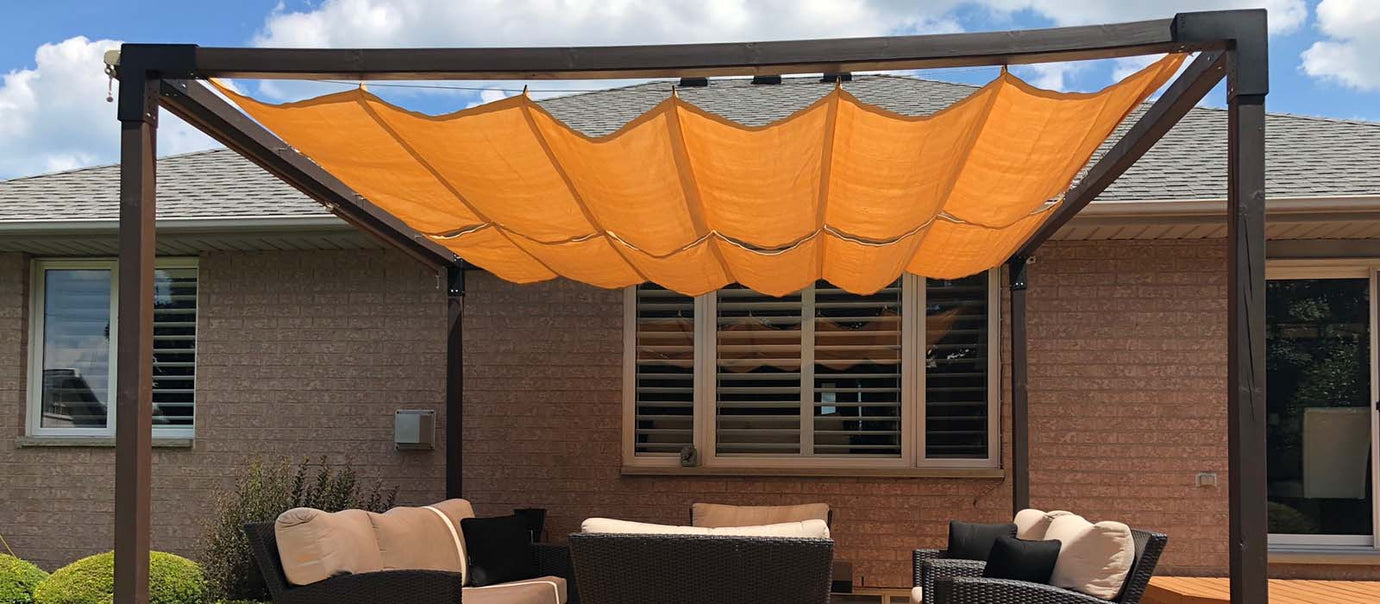Our YouTube channel includes detailed installation guides, frequently asked questions, product overviews and lots more. We are always open to content ideas so please let us know if there is a topic you would like us to cover.
How to Shade a Patio

Patios are where we gather for family BBQs, unwind with a book, or simply enjoy the outdoors. But without proper shade, even the most beautifully built patio can become too hot or uncomfortable to enjoy.
In this guide, we’ll walk you through how to shade a patio—covering everything from early construction considerations to anchoring techniques and the best shade solutions for your space. Whether you're planning a new patio or upgrading an existing one, these insights will help you make the most of your outdoor area.
Contents
- Construction Status
- Important Considerations
- The thickness of your slab
- The surrounding area
- Frames vs Spans
- Anchor Points & Posts
- Cabling
- Existing structures
- Bolting to the patio
- Installing the posts inside of the patio perimeter
- Positioning posts outside of the patio perimeter


Construction Status
Incomplete
If you’re designing your shade system at the same time as your patio, this gives you maximum flexibility. It allows you to choose optimal post placement and integrate your shade structure seamlessly. Whether using a Shade Sail or Roman Shade, planning ahead ensures strong anchoring without compromising aesthetics.
Complete
Most people add shade after their patio is built. That’s totally fine—just pay attention to post placement and anchor points. You can still achieve great results by attaching to existing structures, placing posts just outside the patio perimeter, or using cable systems to improve flexibility.

Important Considerations
Before selecting anchor points or shade types, it’s important to evaluate the existing conditions of your patio.
The thickness of your slab
Thicker slabs may prevent you from digging post holes or bolting directly. Ensure your patio is structurally sound for the type of installation you plan. This is especially important when tensioning fabric like shade sails.
The surrounding area
Look for natural or built structures nearby that could serve as anchor points. Also consider where you can dig for post installation—typically 3 to 4 feet deep. Knowing these factors ahead of time will save you time, money, and headaches.


Frames vs Spans
Spans
Spanning fabric—like shade sails—over the patio without a frame is simple and visually striking. Posts are usually placed outside the patio, creating clean lines and minimizing obstruction. Just keep in mind: these systems require substantial footings to support tension.
Pergola Frames
Using a frame reduces the need for deep footings. Shade tension is absorbed by the pergola beams, making installation easier and faster. Frames also open the door to products like Roman Shades or Privacy Panels, which hang cleanly between beams.


Anchor Points & Posts
Choosing the right anchor points is key to building a secure, functional shade system. We have a detailed guide discussing anchor point hardware, which can help you choose the right hardware for your space.
Cabling
Cable extensions give you flexibility in placement. For example, if your ideal anchor points are wider than your shade sail, you can use cable to bridge the gap—allowing for creative layouts and reducing the need for additional posts.
Existing Structures
Walls, rooflines, and beams make excellent anchor points. This can save money and simplify installation. However, if your patio is too far from these structures, you’ll need to install posts.

Bolting to the Patio
Bolting works well if you're using a pergola frame. However, do not bolt a single post directly to the slab when tensioning a shade sail—it won’t hold the force and could cause damage.
Installing the Posts Inside the Patio Perimeter
Only practical if you’re building the patio around the post, or if you’re okay removing some pavers to install them later. This is a clean solution but involves more prep and planning.
Positioning Posts Outside the Patio Perimeter
The most common and flexible method. Posts don’t interfere with your layout and can be dug deeper into stable ground. Just make sure the dig site is free of gas lines, water pipes, or electrical.


Frequently Asked Questions
What’s the easiest way to shade a patio without building a structure?
Shade sails are one of the simplest and most affordable ways to add shade without framing. They can attach to existing structures or poles installed around the patio.
Can I add shade to a finished patio without removing pavers?
Yes! You can install posts around the perimeter or use wall-mounted brackets and cable systems to avoid disturbing your patio surface.
Do I need a permit to install a patio shade structure?
This depends on your local bylaws. Smaller, non-permanent installations usually don’t require a permit, but it's best to check with your municipality if you’re installing posts or large frames.
Is waterproof fabric available for patio shade?
Yes. While most shade sails are breathable, we also offer waterproof options like our DriZ fabric—great for all-weather protection.


Conclusion
Understanding how to shade a patio the right way means thinking ahead—whether you're building from scratch or upgrading an existing space. By assessing construction status, anchor options, and layout needs, you can choose a solution that balances form, function, and flexibility.
Whether you go with a frame, a sail, or a custom system, planning it properly ensures your patio becomes the comfortable, shaded outdoor retreat you’ve been dreaming of.



